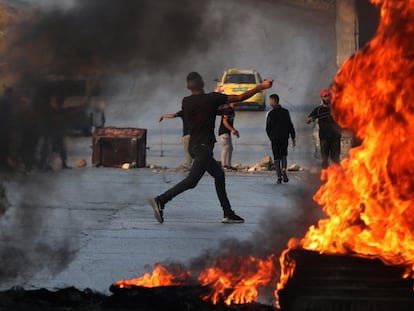Disinformation opens a new front in the Hamas-Israeli conflict: Beheadings, cages and fake memos
Supporters of both sides are using the internet to spread fake news and propaganda. This has prompted the EU to demand greater stringency from the social media platforms X, TikTok and Facebook

The most recent high-profile figure to fall for misinformation was Joe Biden. The U.S. president said Wednesday: “I never really thought that I would see, have confirmed, pictures of terrorists beheading children.” The Democrat leader made this comment following a meeting in Washington with leaders of the Jewish community. And it spread like wildfire. It came a day after a reporter from the Israeli channel i24 reported the beheading of 40 minors by Hamas militants.
After Biden’s comment, the White House tried to walk back the claim, stating that the president had not seen the images nor confirmed the atrocity, and that his comment was based on statements from the office of Israeli Prime Minister Benjamin Netanyahu and Israeli press. Unverified news was thus given a springboard by the leader of the world’s leading power, a valid source of information for public opinion.
The U.S. president’s claims about the beheadings were met with hundreds of posts on X (formerly Twitter), with users divided between “Biden confirms” and “Biden lies.” Manuel R. Torres Soriano, an expert in propaganda and terrorism, explains this response to disinformation is linked with “receptivity.” That is, if I sympathize with Palestine it will be easier for me to question such a savage attack, while if I lean towards Israel I will believe Biden, even if the White House steps back the claims.
“Unlike Ukraine, there is an added difficulty here,” says Torres Soriano, who is professor of Political Science at the Pablo de Olavide University in Seville in Spain. “In Europe, there is a clear position with Russia, which tries to contaminate [with disinformation] and against which society is immunized. Now [in the conflict between Hamas and Israel], the positioning is not so clear.”
What is clear, according to the experts who monitor the social media, is that disinformation and propaganda is being spread from both sides and at unprecedented levels. From Hamas propaganda praising and exploiting its attack on Israeli territory as a sign of strength, to Israel’s efforts to associate the “terrorist” label to everything linked Palestinian armed group, which it equates to the Islamic State (ISIS), even though it was near annihilated four years ago in northern Syria.
i24NEWS Correspondent @Nicole_Zedek reports from Kibbutz Kfar Aza, a quarter-mile from the Gaza border, and recounts the atrocities that were committed in the small community which remains an active scene as soldiers clear booby traps and recover the bodies of dozens of victims pic.twitter.com/J4ZfWZQYHp
— i24NEWS English (@i24NEWS_EN) October 10, 2023
The information about the beheadings — which was broadcast on Tuesday on i24, an Israeli channel owned by tycoon Patrick Drahi — has triggered a heated debate about misinformation. These are the facts: i24 journalist Nicole Zedeck reported on Tuesday, from the kibbutz (Israeli agricultural cooperative) of Kfar Aza, which was massacred by the Palestinian militant group, that “some soldiers” told her that there were children with “severed head.” In her X profile, she added that about 40 “children/babies” were murdered, according to her sources.
According to i24 videos, one of the soldiers who spoke to her about the beheadings was David Ben Zion, the deputy commander of an Israeli military unit and settler leader with a clear political profile. In just 24 hours, Zedeck’s TV report received 44 million views, 300,000 likes and 100,000 reposts, according to Middle East disinformation expert Marc Owen Jones. It went viral, and its spread on social media was impossible to stop.
The atrocious Hamas attack on Kfar Aza killed dozens of people, adding to the 1,300 fatalities recorded so far in Israel. Images taken at the scene proved that minors had been killed. But neither the Israeli government nor the army have so far offered evidence of the beheading of 40 children. Even so, soldier Ben Zion’s message was repeated by politicians like President Biden.
“Each conflict has more media coverage than the last,” says Professor Torres Soriano. “It happened with Ukraine. It is a nonstop spiral, and with Israel-Palestine it will be even greater.” “The flow of information is not limited to the two contenders,” he continues. “Many other actors are participating, such as Ukraine, China, the Gulf countries, Iran and Latin America. They already have a slick machinery and are taking advantage of the new window that has opened.”
The disinformation has two sides to it. The first, as seen with the report from Kfar Aza, is linked to traditional sources (the army, government, journalists etc.). The second works through individuals who, as Torres Soriano points out, “feel called to take part in a global debate.” In the case of the Middle East conflict, this debate is charged with emotions and deeply divisive.
Orrendo video pubblicato da Hamas: bambini israeliani rapiti tenuti in gabbie per animali. L’autore del video sghignazza. E ci sono varie altre gabbie pronte. pic.twitter.com/5xmBtfljL9
— Lucio Malan (@LucioMalan) October 8, 2023
There are hundreds of examples of this second side. On Sunday, 24 hours after Hamas entered Israeli territory, Lucio Malan, an Italian senator for the far-right Brothers of Italy party, tweeted a video in which five children appeared in cages. Malan said in his post that they had been “kidnapped” by the Palestinian militia. But that was not the case. The Israeli investigative project FakeReporter — which is doing an excellent job of fact-checking along Palestinian platforms Kashif and Tahaqaq — raised the alert and clarified that it was shared online before the Hamas offensive. Although this context has now been added below the video on Malan’s post, the senator has not deleted it from his profile.
One of the tactics used by Hamas militants to reach Israel was via paragliders. In another example of fake news, Paul Golding, leader of the far-right Britain First party, tweeted a video on Sunday showing dozens of men descending from the air onto sports facilities. “Hamas paragliders in action,” he posted. But that was not the case either. Through freely available verification tools, it was concluded that the video is of a military exercises held in Egypt in September.
Since the Hamas attack on Saturday, one of the most viral messages on social media has been the announcement that Biden was approving a new military aid package to Israel worth $8 billion. The photo of the alleged document has spread quickly on social networks. But it was also untrue. The verification unit of the AFP news agency, among others, analyzed the paper and the contents of the U.S. government document and concluded that it was doctored. The real memo was intended to approve Ukraine aid, and was signed on July 25.
Video says it's an Egyptian military exercise.
— factfinder (@posttruth2030) October 8, 2023
The tide of fake news is so great that the European Union — one of the most active institutions in the fight against disinformation — urged social media platforms to take action to stop the spread of misinformation. EU Commissioner for the Internal Market Thierry Breton warned X and Facebook to curb these types of messages in compliance with the EU Digital Services Act, which was approved in Brussels last year. A day later, Breton also sent a warning letter to TikTok.
The social media platform X — which is owned by U.S. billionaire Elon Musk — reported on Thursday that it had eliminated hundreds of accounts linked to the Islamist group Hamas. But that was not enough to appease the EU. The European Commission has opened an investigation to find out whether X complies with the new European regulation on “illegal and harmful” content.
But FakeReporter warns, that there are other social networks that are less visible and used to host unverified videos, photos and text. The main one is Telegram, a platform based in Dubai, but with Russian roots, which has during the war in Ukraine has emerged as the favorites of both public and private actors. “One of the main challenges we have,” FakeReporter told EL PAÍS, “is the lack of regulation by social media companies and their inability to moderate their platforms. Some, like Telegram, where horrible things are spread and groups are organized, are practically untouchable.”
Much of the content about the war between Hamas and Israel being spread by X users has previously gone through Telegram. Professor Torres Soriano agrees that Telegram is a concern: “For many, it’s the only haven of freedom, with individual actors who have their clientele and sell their product, with messages like ‘this won’t be told to you by the media.’”
Sign up for our weekly newsletter to get more English-language news coverage from EL PAÍS USA Edition
Tu suscripción se está usando en otro dispositivo
¿Quieres añadir otro usuario a tu suscripción?
Si continúas leyendo en este dispositivo, no se podrá leer en el otro.
FlechaTu suscripción se está usando en otro dispositivo y solo puedes acceder a EL PAÍS desde un dispositivo a la vez.
Si quieres compartir tu cuenta, cambia tu suscripción a la modalidad Premium, así podrás añadir otro usuario. Cada uno accederá con su propia cuenta de email, lo que os permitirá personalizar vuestra experiencia en EL PAÍS.
¿Tienes una suscripción de empresa? Accede aquí para contratar más cuentas.
En el caso de no saber quién está usando tu cuenta, te recomendamos cambiar tu contraseña aquí.
Si decides continuar compartiendo tu cuenta, este mensaje se mostrará en tu dispositivo y en el de la otra persona que está usando tu cuenta de forma indefinida, afectando a tu experiencia de lectura. Puedes consultar aquí los términos y condiciones de la suscripción digital.
More information
Archived In
Últimas noticias
Most viewed
- Sinaloa Cartel war is taking its toll on Los Chapitos
- Oona Chaplin: ‘I told James Cameron that I was living in a treehouse and starting a permaculture project with a friend’
- Reinhard Genzel, Nobel laureate in physics: ‘One-minute videos will never give you the truth’
- Why the price of coffee has skyrocketed: from Brazilian plantations to specialty coffee houses
- Silver prices are going crazy: This is what’s fueling the rally











































